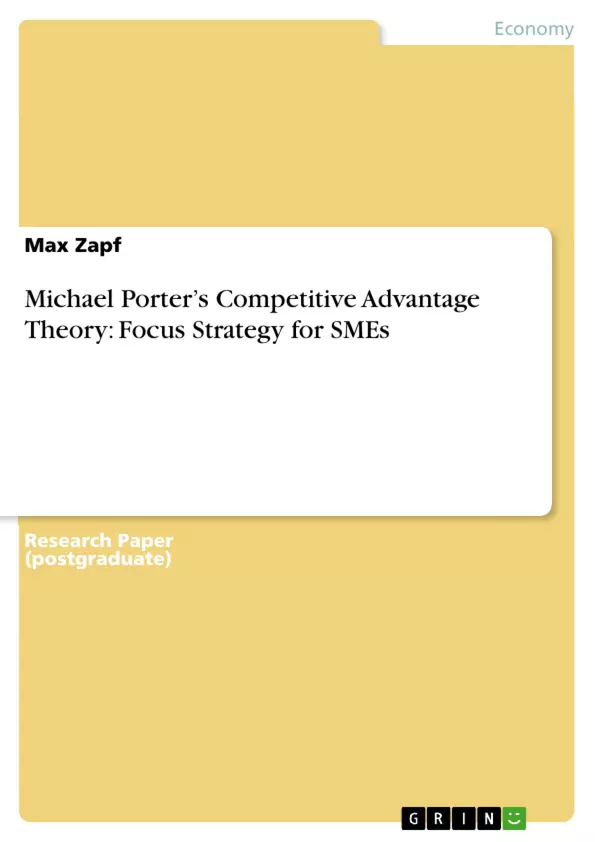
Michael Porter’s Competitive Advantage Theory: Focus Strategy for SMEs
Forschungsarbeit, 2008
16 Seiten, Note: A
Leseprobe
Table of Contents
- 1. Introduction
- 2. Theoretical Background and Hypothesis
- 3. Focus Strategy and Competitive Advantage
- 4. Porter's Focus Strategy and Criticism
Objectives and Key Themes
This report aims to determine whether small and medium-sized enterprises (SMEs) focusing on niche markets are more effective in promoting their products and services than those targeting the mass market. It analyzes Michael Porter's focus strategy within the context of SMEs, examining its advantages and limitations.
- Effectiveness of focus strategy for SMEs in product promotion
- Porter's focus strategy: advantages and limitations
- Competitive advantage for SMEs in niche markets
- Empirical evidence from a SME survey
- Cost and differentiation in focus strategy
Chapter Summaries
1. Introduction: This introductory chapter sets the stage for the research by clearly stating the central research question: whether SMEs targeting niche markets achieve more effective product promotion compared to those targeting the mass market. It outlines the methodology, which combines theoretical analysis of Porter's focus strategy with empirical data from a survey of 30 SMEs in Southern Germany. The chapter establishes the groundwork for the theoretical and practical investigations that follow, emphasizing the importance of understanding the competitive landscape for SMEs.
2. Theoretical Background and Hypothesis: This chapter delves into the theoretical underpinnings of the research, primarily focusing on Michael Porter's generic competitive strategies, particularly the focus strategy. It explains market segmentation and Porter's concept of "stuck in the middle," highlighting the importance of clear strategic choices for achieving competitive advantage. The chapter also incorporates perspectives from other authors who support or challenge Porter's views, presenting a nuanced understanding of the focus strategy's role in achieving competitive advantage for firms. The chapter culminates in the formal statement of the research hypothesis, which posits that SMEs targeting mass markets will promote their products and services more effectively than those targeting niche markets. This hypothesis sets the stage for testing the theory using empirical data presented in subsequent chapters.
3. Focus Strategy and Competitive Advantage: This chapter elaborates on Porter's focus strategy, discussing how a significant differentiation (through cost or differentiation) can create competitive advantage. It explains how this differentiation, if costly to imitate and fulfilling market needs, creates barriers to entry for competitors, reduces buyer power, and mitigates the threat of substitutes. This analysis of Porter's Five Forces framework is central to the chapter's argument. The impact on supplier power is explored depending on the type of focus strategy employed, with product focus reducing supplier power through bulk orders. The discussion connects these aspects of Porter's model directly to the competitive landscape faced by SMEs.
4. Porter's Focus Strategy and Criticism: This chapter critically examines Porter's focus strategy. It acknowledges the limitations of Porter's framework, arguing that a focus strategy alone doesn't guarantee effective product promotion. The chapter focuses on the reactions of larger competitors to SMEs entering their niche markets. Two possible reactions are described: accommodation or aggressive deterrence. This discussion adds complexity to the analysis, showing that the success of a focus strategy for SMEs depends on not only the internal implementation of the strategy but also on the external reactions from larger competitors. The chapter sets the stage for the practical investigation into these dynamics with empirical data.
Keywords
Small and medium-sized enterprises (SMEs), Michael Porter's competitive advantage, focus strategy, niche markets, mass market, market segmentation, competitive advantage, cost leadership, differentiation, product promotion, empirical research, Southern Germany, SME survey.
Frequently Asked Questions: A Comprehensive Language Preview on Focus Strategies for SMEs
What is the main research question addressed in this report?
The report investigates whether small and medium-sized enterprises (SMEs) focusing on niche markets are more effective in promoting their products and services than those targeting the mass market.
What theoretical framework is used in this report?
The report primarily uses Michael Porter's generic competitive strategies, specifically the focus strategy, as its theoretical foundation. It also considers perspectives from other authors who support or challenge Porter's views.
What are the key themes explored in the report?
Key themes include the effectiveness of the focus strategy for SMEs in product promotion, the advantages and limitations of Porter's focus strategy, competitive advantage for SMEs in niche markets, empirical evidence from a SME survey, and the role of cost and differentiation in the focus strategy.
What methodology is employed in the research?
The methodology combines a theoretical analysis of Porter's focus strategy with empirical data from a survey of 30 SMEs in Southern Germany.
What are the chapter summaries?
Chapter 1 introduces the research question and methodology. Chapter 2 delves into the theoretical background and hypothesis. Chapter 3 elaborates on Porter's focus strategy and competitive advantage. Chapter 4 critically examines Porter's focus strategy and its limitations, considering reactions from larger competitors.
What is Porter's focus strategy, and how is it discussed in the report?
The report extensively discusses Porter's focus strategy, explaining how significant differentiation (through cost or differentiation) can create competitive advantage. It analyzes how this differentiation creates barriers to entry, reduces buyer power, and mitigates the threat of substitutes, within the context of Porter's Five Forces framework. The report also critically examines the limitations of this strategy and considers the reactions of larger competitors.
What are the limitations of Porter's focus strategy as discussed in the report?
The report acknowledges that a focus strategy alone doesn't guarantee effective product promotion. It emphasizes that the success of a focus strategy depends not only on internal implementation but also on external reactions from larger competitors, such as accommodation or aggressive deterrence.
What kind of empirical data is used in this report?
The report uses empirical data from a survey of 30 SMEs in Southern Germany to support its analysis and test its hypothesis.
What is the hypothesis of the research?
The hypothesis posits that SMEs targeting mass markets will promote their products and services more effectively than those targeting niche markets.
What are the keywords associated with this research?
Keywords include: Small and medium-sized enterprises (SMEs), Michael Porter's competitive advantage, focus strategy, niche markets, mass market, market segmentation, competitive advantage, cost leadership, differentiation, product promotion, empirical research, Southern Germany, SME survey.
Details
- Titel
- Michael Porter’s Competitive Advantage Theory: Focus Strategy for SMEs
- Hochschule
- Hochschule für Technik und Wirtschaft Chur
- Veranstaltung
- MSc Entrepreneurship
- Note
- A
- Autor
- Max Zapf (Autor:in)
- Erscheinungsjahr
- 2008
- Seiten
- 16
- Katalognummer
- V171572
- ISBN (Buch)
- 9783640909162
- ISBN (eBook)
- 9783640911363
- Dateigröße
- 576 KB
- Sprache
- Englisch
- Schlagworte
- SME Small-medium enterprises focus strategy Michael Porter Differentiation Strategy Cost Strategy
- Produktsicherheit
- GRIN Publishing GmbH
- Preis (Ebook)
- US$ 17,99
- Preis (Book)
- US$ 19,99
- Arbeit zitieren
- Max Zapf (Autor:in), 2008, Michael Porter’s Competitive Advantage Theory: Focus Strategy for SMEs, München, Page::Imprint:: GRINVerlagOHG, https://www.diplomarbeiten24.de/document/171572
- Autor werden
- Ihre Optionen
- Vertriebskanäle
- Premium Services
- Autorenprofil
- Textarten und Formate
- Services für Verlage, Hochschulen, Unternehmen

- © GRIN Publishing GmbH.
- Alle Inhalte urheberrechtlich geschützt. Kopieren und verbreiten untersagt.
- info@grin.com
- AGB
- Open Publishing
Der GRIN Verlag hat sich seit 1998 auf die Veröffentlichung akademischer eBooks und Bücher spezialisiert. Der GRIN Verlag steht damit als erstes Unternehmen für User Generated Quality Content. Die Verlagsseiten GRIN.com, Hausarbeiten.de und Diplomarbeiten24 bieten für Hochschullehrer, Absolventen und Studenten die ideale Plattform, wissenschaftliche Texte wie Hausarbeiten, Referate, Bachelorarbeiten, Masterarbeiten, Diplomarbeiten, Dissertationen und wissenschaftliche Aufsätze einem breiten Publikum zu präsentieren.
Kostenfreie Veröffentlichung: Hausarbeit, Bachelorarbeit, Diplomarbeit, Dissertation, Masterarbeit, Interpretation oder Referat jetzt veröffentlichen!
- GRIN Verlag GmbH
-
- Nymphenburger Str. 86
- 80636
- Munich, Deutschland
- +49 89-550559-0
- +49 89-550559-10
- info@grin.com
-









